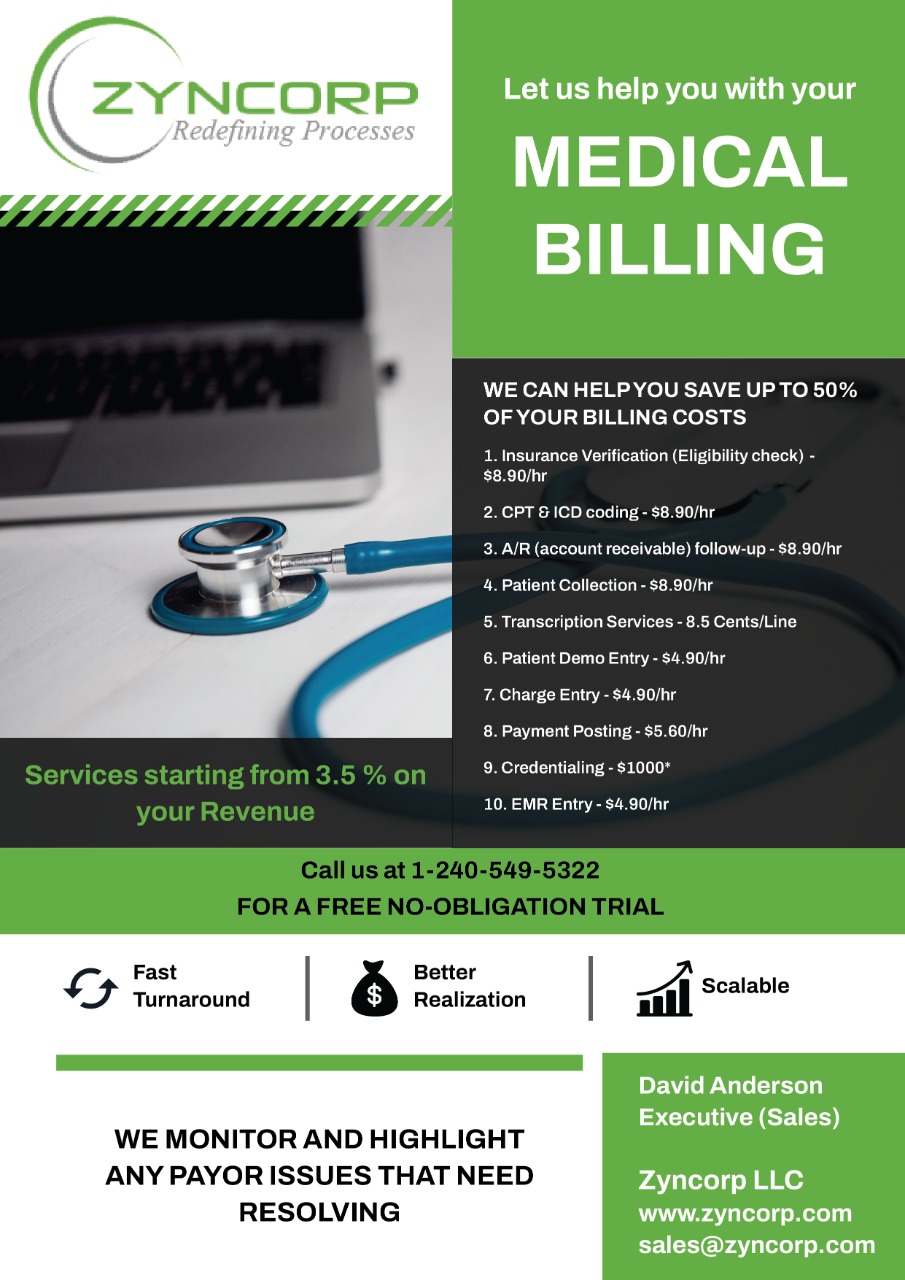 Uncategorized
Uncategorized
ZYNCORP CAN HELP YOU SAVE UP TO 50% OF…
Service starting from 3.5% on your Revenue

 Uncategorized
Uncategorized
Service starting from 3.5% on your Revenue

 Uncategorized
Uncategorized
REVENUE CYCLE MANAGEMENT
Revenue Cycle Management is the method of managing claims processing, payment, and revenue generation. This includes everything from determining the patient’s eligibility, collecting their copay, coding the claims, collecting payments, tracking the claims, and following up on denied claims. As a critical part of any practice, the entire revenue cycle and account receivable process must be managed efficiently.
POINTERS TO POORLY PERFORMING REVENUE AND ACCOUNT RECEIVABLES
A key element to a slowdown in cash collections is that third party insurance companies, Medicare avoids paying claims by requiring that invoices comply perfectly with their requirements. To further burden the provider, they change these conditions at will.
Also, Practices that need an account receivables turnaround may lack internal controls (i.e., the ability of the patient financial business office to control itself), low morale, anxiety on the part of the staff, and a staff that lacks the skills and training necessary to perform effectively. Other contributing factors include; an inadequate collaboration between revenue cycle departments.
ACCOUNT RECEIVABLES CONSIDERATIONS FOR PROPER REVENUE CYCLE MANAGEMENT
When embarking an account receivables turnaround, if you believe that you need drastic action, you first need to have a plan (and you’ll always know what the next step needs to be). This is very important because the busier you’re, the more you need to plan. The next important consideration is to determine if you’ve enough resources to reach your cash and account receivable objectives.
Engaging the assistance of a revenue cycle consultant is another consideration in that most of these individuals are seasoned and have no bias that may affect the decision-making process. As a result, they make the required decisions regardless of the popularity of those decisions or political implications. Revenue cycle consultants can assist practices to re-design ineffective workflows, procedures, and processes while spending considerable time in training the staff. These experts concentrate on managing operational aspects relating to change without becoming unnecessarily entangled in the internal battles that can often derail turnaround efforts.
Guidelines Needed To Achieve Adequate Account Receivables and Revenue Management.
Finally, finding solutions to a troubled medical revenue cycle is no easy feat. Practices first need to determine precisely what is wrong with their revenue cycle and then have a road map that will achieve the necessary changes while maintaining cash flow in the interim. Whichever method you decide to apply during the account receivable turnaround attempt, remember that proper planning and allocating the right resources to produce maximum performance are paramount.
 Uncategorized
Uncategorized
TIPS TO REDUCING CLAIM DENIAL RATE
Reducing claim denials should be a continuous effort. Every medical practice should consciously work toward improving office efficiency and cash flow. This invariably implies that claim denial is reduced to the least possible rate. Having a high denial rate means more time and money spent on reworking and resubmitting claims to payers. There are practical steps that can help your practice reduce denials. These tips will help you understand how your practice can reduce denial claims to a minimum level and maintain the industry standard denial rate of 2% to 5%.
AWARENESS OF THE MAJOR REASONS FOR CLAIM DENIALS
The first step to reducing denials is compiling your claim adjustment reason codes accurately and making them easier to identify. This will help provide a bottom line on how you can build a denial management strategy. For instance, denials can be categorized by common reasons such as Demographic errors such as an
BE CAUTIOUS OF DEADLINES AND CHECK FOR ACCURACY
Minor errors can cost you money and your practice time. Reviewing each claim for accuracy may seem like a lot of work, but it will pay off as well as save time and resources. Practice bill denial rate from untimely filing should be 0%.
BE AWARE OF SIGNIFICANT CHANGES
The health care industry is ever-changing and dynamic. Billing staff should be in close communication with all Centers for Medicare Services and the insurance company’s in-house coding standards. Billing companies should make it a duty to share important updates with the entire practice as information becomes available. This will ensure that everyone within your practice is on the same page. This will also reduce any surprises when it comes to the ever-changing medical coding environment.
ENGAGE A MEDICAL BILLING COMPANY
The chance of errors occurring can easily increase if your practice staff handles too many operations at once. Part of the concern when submitting claims is the risk of human error as mentioned above. There’s a constant need to recheck, but what if there isn’t enough time? Bringing in a medical billing company can reduce the rate of claim denial. These companies have coders in place who are familiar with the dynamic nature of medical coding along with the required software that is built to check for errors that can lead to denials.
Finally, the American Medical Association (AMA) in a recent study found that on average almost $15,000 per year is spent on appealing, investigating, and reworking denied claims. This implies a huge chunk of what healthcare providers work for leading to losses that otherwise could have been avoided if the above tips are employed.
 Uncategorized
Uncategorized
MANAGING OVERDUE PATIENT BILLS
Debt collection not only hurts and agitates your patients but if handled poorly, can also damage your hard-earned relationship with your dental patients. Have it in mind that dental practices are not immune to patients not paying their bills on time. Late or overdue payments affect your business cash flow, thus affecting your ability to pay your debts on time.
Here are some basic and straightforward guidelines that can help you navigate this uncertain territory:
IN CONCLUSION
Debt collection and management services are also available for outsourcing and might be a wise decision for your business if you see accounts receivable delay the past ninety days. If you decide to outsource your debt collections to another firm, have ample time to investigate them thoroughly beforehand. Ensure they do not have any valid and evident complaints against them (all debt collection companies always receive complaints because people do not like paying their dental bills). Also, check up on their certification update, regulations followed, and how often their staff goes through training. The world of debt collection is filled with many rules that are always changing. You must place your business in the hands of people that are not running up and down with lawsuits throughout the year. More importantly, hire a debt collection company with dental experience – they need to know how to read and understand insurance information as well as insurance companies if that becomes necessary.
 Uncategorized
Uncategorized
DIFFERENT APPROACHES TO AGING AND AGING STRATEGIES
It has indeed been established that most of the lost revenue in medical offices is as a result of the aging report not being worked regularly. This implies that the aging of your account receivables is vital to watch because the older bills get, the harder and more expensive they become to collect. The rise in the patient’s financial responsibility in the recent past has even compounded the challenge in resolving aged receivables. With the multitude of new health insurance plans available to patients who are unfamiliar with how it works, medical practitioners continually have increasing aged bills, thus affecting their account receivables. It, therefore, becomes imperative for practices to a thinker of different approaches as well as develops strategies that will effectively minimize aged medical bills.
Here are a few steps;
HAVE DETAILED ANALYSIS SYSTEMS
There is every need that your practice develops a system of tracking patients’ account receivables. Have a clear opinion of what is driving your patient’s account receivables and do not treat all bills as a whole. Once you notice that the patient’s bill is rising quickly, for example, that could imply inconsistencies in your front-desk processes or the way employees interact with patients about your practice’s financial policy. It could also point to a more significant issue relating to centralized billing deficiency. Therefore all systems must be analyzed, and shortfalls treated immediately to prevent aging bills.
ESTABLISH A HIGH PRIORITY DESK FOR INSURANCE VERIFICATION
Once your practice can ensure, check, and double-check a patient’s insurance coverage and eligibility, then the issue of aged bills will not arise. This requires a proactive and robust system being put in place for this. Most systems for this seek to verify information like whether the patient has coverage and if deductibles are available for the patient or operating a policy that has already been suspended due to non-payment of premiums. It is therefore paramount that practice employees notify their patients of their findings even before they seek medical care. If this is done, the massive amount of workers employed in tracking aged medical billing will be reduced.
PATIENT’S ENGAGEMENT IS IMPORTANT
For any practice that intends to avoid excessive aged medical billing, then it’s crucial the practice engages patients early about expectations of their bill so that requests for payment will not come to them as a surprise. This step does not end with providing patients with your payment policy or reminding them of their balances but also requires providing patients easy ways to connect with the practice and pay their bills. With all various types of technology available, tools like an online portal, and other convenient methods of payment can be provided to patients for easy access.
IN CONCLUSION
Aging of medical bills can be significantly minimized if practices employ workable strategies as itemized above. Also, insist that errors with regards to failed or denied claims be corrected by the employee who made a mistake so that he or she will learn from the mistake and not start a cycle of denied claims. The feedback loop is essential. Engaging employees in finding a solution is the best strategy for solving this issue of aging medical bills.